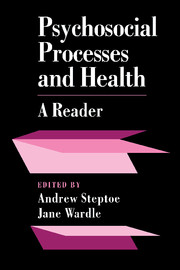Book contents
- Frontmatter
- Contents
- Preface
- Section 1 Life stress, social support and health
- Section 2 Psychophysiological processes in disease
- Section 3 Personality, behaviour patterns and health
- Section 4 Health practices and the modification of health risk behaviour
- Section 5 Coping with illness and disability
- Section 6 Behavioural interventions in medicine
- Randomised controlled trial of nicotine chewing-gum
- Conditioned side effects induced by cancer chemotherapy: prevention through behavioral treatment
- Improvement of medication compliance in uncontrolled hypertension
- Effect of psychosocial treatment on survival of patients with metastatic breast cancer
- Alteration of type A behavior and its effect on cardiac recurrences in post myocardial infarction patients: summary results of the recurrent coronary prevention project
- Can lifestyle changes reverse coronary heart disease? The Lifestyle Heart Trial
- Index
Randomised controlled trial of nicotine chewing-gum
from Section 6 - Behavioural interventions in medicine
Published online by Cambridge University Press: 05 August 2016
- Frontmatter
- Contents
- Preface
- Section 1 Life stress, social support and health
- Section 2 Psychophysiological processes in disease
- Section 3 Personality, behaviour patterns and health
- Section 4 Health practices and the modification of health risk behaviour
- Section 5 Coping with illness and disability
- Section 6 Behavioural interventions in medicine
- Randomised controlled trial of nicotine chewing-gum
- Conditioned side effects induced by cancer chemotherapy: prevention through behavioral treatment
- Improvement of medication compliance in uncontrolled hypertension
- Effect of psychosocial treatment on survival of patients with metastatic breast cancer
- Alteration of type A behavior and its effect on cardiac recurrences in post myocardial infarction patients: summary results of the recurrent coronary prevention project
- Can lifestyle changes reverse coronary heart disease? The Lifestyle Heart Trial
- Index
Summary
Abstract
The effectiveness of 2 mg nicotine chewing-gum as an aid to stopping smoking was compared with a placebo containing 1 mg nicotine, but unbuffered, in a double-blind randomised trial. Of 58 subjects given the active gum, 27 (47%) were not smoking at one-year follow-up compared with 12 (21%) of the 58 subjects treated with placebo (p< 0-025). By the most stringent criterion of outcome, 18 (31%) subjects in the active treatment group and eight (14%) in the placebo group had not smoked at all from the start of treatment to follow-up at one year (p<0-05).
Subjects receiving the active gum experienced less severe withdrawal symptoms and rated their gum as more helpful than did the placebo group. Minor side effects were common but only gastric symptoms were more frequent with the active gum. Subjects receiving active gum used it for longer than those receiving placebo but most stopped using it within six months and only four (7%) developed longer-term dependence. The number of gums used daily correlated significantly with pretreatment blood nicotine concentrations in the active treatment group and with pretreatment cigarette consumption in the placebo group. A lower pretreatment blood nicotine value was the best predictor of success at one year (p< 0-001) but there was no significant relation to cigarette consumption, sex, and social class.
The results clearly confirm the usefulness of nicotine chewing-gum as an aid to stopping smoking and imply a definite role for nicotine in cigarette dependence and withdrawal. Successful use of the gum requires careful attention to subjects’ expectations and clear instructions on how to use it.
Introduction
Many smokers give up smoking without any special help or treatment, but others have great difficulty and fail many times. The first smoking-cessation clinic was started in Stockholm in 1955. Since then there has been an intensive search for an effective treatment for dependent smokers. Simple support and encouragement, given individually or in groups, has a success rate of around 15-25% abstinent at one-year follow-up. Numerous other methods have been tried, including tranquillisers, lobeline, electric aversion therapy, rapid smoking, hypnosis, and, more recently, acupuncture. None of these methods, however, has been found to have a specific effect over and above the attention-placebo element inherent in any treatment.
- Type
- Chapter
- Information
- Psychosocial Processes and HealthA Reader, pp. 427 - 438Publisher: Cambridge University PressPrint publication year: 1994
- 1
- Cited by



